Senyava 1915. Perfect night attack
At the front of the 3 Army, the main attack of the enemy of the 11 Army took place on the positions of the 5 Army in the Caucasus. The enemy opened strong artillery fire at the central combat section of the 3 Caucasian Rifle Division and, attacking it with considerable forces, forced them to retreat to the Bobruvka-Drezina front. The division, having repelled several attacks, suffered serious losses. So, in the 9 and 11 m Caucasian rifle regiments, 1 thousand people are left (25% of the state), in the 10 m Caucasian rifle regiment - 300 (7,5% of the state), and in the 12 m Caucasian rifle shelf - 200 (5% of the state) people; some of the regiment commanders and batteries were out of order. The 3-I Caucasian Rifle Division actually ceased to be a division.
The commander of the 3 Army decided to thwart the enemy offensive and divert his attention from the junction of the two armies - he ordered the left flank of his army (24, 29 and 5 Caucasian Army Corps) in 20 - 21 hour to go on the offensive . But the German circumvention of the flank of the 45 infantry division thwarted this plan.
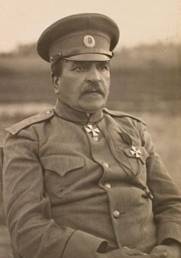
The onslaught of the Austro-Germans in the positions of the 3 and 8 armies
The withdrawal of the 3 Caucasian Rifle Division had one more unfavorable consequence - German units bypassed the left flank of the 29 Army Corps. The corps began to depart beyond the river. Lyubachevka, having advanced between the left flank and the right flank of the 5-th Caucasian Army Corps the 3-th Don Cossack Division. On the night of the 11 on the 12 of May, leaving behind p. Lyubachevka, the 29th Army Corps was occupied by the Ignace-Surmachovka-Polanka front. The 5-th Caucasian Corps was on the front of Zagrada - Lazy.
The enemy forced the river. Sun continued to squeeze the 21 Army Corps. At Zabloce - Dragoyuv the 12th Infantry Division of the 12th Army Corps was hardly restrained.
The enemy was advancing from Radymno in a southeasterly direction (82-I reserve division), 81-I reserve, 11-I Bavarian and 119-I infantry divisions tried to attack in the direction of Mosziska, and 39-I hounded and 12-I infantry divisions acted with a bridgehead on the right bank of the river. Sun at Zagroda - on Dunkovitsy. The German Guard operated on the Zalessky Will.
Having attacked the two left-flank (29 and 5 Caucasian army) corps of the 3 Army, the enemy stopped attacking. The main goal is to drop the 21 and 12 army corps of the 8 army on the right bank of the river. San in order to master the approaches to the fortress of Przemysl - he carried out.
May 12 The 5 Caucasian Army Corps was transferred to the 8 Army.
On this day, the 5-th Caucasian, 21-th and 12-th army corps somewhat moved east (on the Menkysh-Stary-Kharitany-Nenovice-Svetna line).
The most difficult situation has developed on the front of the 8 Army. The cavalry general, A. A. Brusilov, later recalled that the ranks of the troops were small, and the German strike group lay on the shoulders of his army - mainly on the right flank (21 and 12 corps). There were not enough troops, and the struggle in all respects was overwhelming.
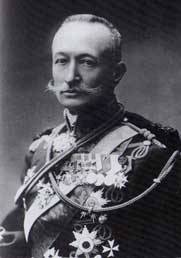
A. A. Brusilov gave the order to the 8 Army: on the night of May 14, move to the front of Shutkov – Velki – Ochi – Krakovec – Mosciska, that is, leave Przemysl. But the withdrawal of the army and the abandonment of Przemysl were canceled - only the 21 and 12 army corps retreated under the pressure of the enemy.
Artillery "detachment" of Germans
Army troops continued to engage in fierce battles with the enemy and 14 - 15 on May. The officer of the 33-th artillery brigade of the 21-th army corps recalled an alarming telephone beep, announcing the attack of the Germans - who were coming in thick, convoys. The batteries rumbled, firing hundreds of shells. On the field, ahead of the artillerymen, there was a entrenched infantry. The soldiers laid their rifles on the ground thrown out of the trenches - and the bayonets stick out menacingly towards the advancing enemy. The latter, in solid columns and thick chains, as far as the eye sees, covers the field - from the very line of villages. Here are gray-green Germans and blue-gray Austrians. The Russian artillery is mercilessly beating the enemy - along the entire advancing front. Hundreds of shells burst in the ranks of the enemy infantry - tear the Austro-Germans to pieces, tumble down in whole columns.
The enemy infantry could not stand it, turned back and ran in a panic, leaving the field entirely covered with the bodies of the wounded and killed. And ... an eyewitness could not believe his eyes: the Austro-German infantry was met by the fire of their own batteries. With a quick fire, the enemy hits his infantry, bringing it “to life”, and turns it - forcing it to go on the attack again.
Being under cross fire (their own and another's), the combined Austro-German infantry again turned on the Russians.
Contrary to circumstances
At this time, one of the Siberian batteries died. Being carried away by the battle, having poorly calculated the moment and without charging boxes, she jumped forward - to the open position, chasing the running enemy. As a result, having shot a small supply of shells that were in the front of the guns, came under the blow of the Austro-Germans rushing into a new attack.
And the 6-I (now already consolidated) 14-gun battery fought fiercely without interruption, mowed down the enemy infantry and brutally devastated its ranks, piling heaps of gray-blue and gray-green bodies.
The second enemy infantry attack was also repelled. The Austro-German infantry dispersed, and the Russian infantry surrendered the remnants of two Austrian companies, reaching the Russian trenches with their hands up. 14 people from 200 who went on the attack - such is the terrible statistics for these companies and the fact that allows us to estimate the total loss of enemy infantry.
The 6 battery, the “birthday person” of this battle, at the request of the headquarters of the corps reported the number of shells fired per day - 1200. As a result, a message came from the comcor that if such an "excessive" consumption of shells was repeated, the battalion commander would immediately be removed from command of the battery.
Reporting on the fierce battles on the front of the Austro-Hungarian 2 Army, the Kriegsarhiv notes with surprise the heroic resistance of the Brusilov troops against the background of a lack of ammunition: “Especially surprising is the sacrificial resistance of the Russian troops opposing the Bem-Ermolli and Pukhallo regiments (cavalry general E. von Böhm-Ermalli and artillery general (feltsdeichmeister) P. Puchallo von Brlog - commanders of the 2 and 3-th Austrian armies, respectively - A. O.) ”. As a result, in a few days of combat, the number of active bayonets, for example, the 32th infantry division of the 4th army corps of the Austrian 2th army, decreased from 5200 to 1900.
The 7, 8 and 17 army of the Russian 8 army repelled the onslaught of the enemy’s 2 army. In total, the 8 Army during the crisis period from late April to early June 1915 (6 weeks) captured 53000 prisoners.
Senyavinsky counterattack
In order to avoid a gap between the 3 and 8 armies of the South-Western Front, the actual commander-3 infantry general L. V. (P.) Lesh suggested that the right flank of the 8 army rest against places. Nova - Groble. To strengthen the left flank of his army, L.V. (P.) Lesh concentrated the 13 cavalry divisions behind him on the evening of the 4 of May.
To facilitate the withdrawal of the right flank of the 8 army (primarily the bloodless 21 army corps), the commander of the 3 army ordered the 3 Caucasian, 24 and 29 army corps to go to the 21-22 hours of May 13 on May offensive. A participant in the battles, an officer of the 3 Caucasian Army Corps recalled: “On the 13 of May, on the 3 of the day, the regiment commander handed each of the battalion commanders his own written orders so that they would be announced after the division chief arrived at the regiment. Major General Nekrasov, Head of the Division of His Majesty's Suite, arrived at the regiment on 5 evenings in the evening (Major General K. G. Nekrasov - Commander of the 21-th Infantry Division of the 3-th Caucasian Army Corps) ... he knew how to speak with soldiers and his speech, full of soldier's expressions, caused them to rise. On this day, having approached the position and giving the horse to the orderly, he ordered the regiment (we are talking about the 81 infantry Apsheron Empress Catherine the Second regiment of the 21 infantry division - A.O.) get together near him. Having removed his cap and straightened his thick beard and mustache, the division head turned to the regiment with the following words: “Guys! Absheron dashing! The enemy, the Austrians, in front of you occupy a large place on our river bank in order to accumulate a lot of troops on it and attack us with great forces. Drive him over the river and destroy the bridges. Today at one o’clock in the morning your regiment is attacking sections of the enemy’s position that we defended a week ago. After our retreat, the enemy believes that we are no good, and therefore sleeps at night in his dugouts known to you, without boots and pants, and is not guarded. The most important thing is to keep silence, keep an eye on each other. The sappers will blow up the wire with special charges, all rush there and before the Austrians wake up and jump out of the dugouts, you will be in its trenches. Know that the enemy is strong with his artillery, and without it he doesn’t stand still! ”...“ Gentlemen! ”He addressed, leaving to the officers who were near him,“ always in my life was accompanied by happiness on the 13 number. I am sure that this time it will not leave me. ”
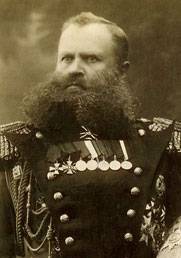
The attack of the 3-th Caucasian Army Corps of the town of Senyava is the standard of a night attack in the First World War.
The front-line soldier recalled that at one o'clock in the morning the whole regiment, as a single organism, advanced into the attack. The distance to the enemy’s trenches is a kilometer. But the enemy discovered a sapper for some reason in front of the 2 battalion: it snapped a rifle shot and started ... In no time, the enemy defense line was surrounded by machine-gun fire that did not harm the Russians - bullets whistled high above the attacking heads (probably, the enemy arrows didn’t accounted for descending to the Russian terrain). Under fire, in some places, the chains were laid down, but at that moment the elongated charges of the sapper began to explode one by one - and a friendly “cheers” burst in the area of the 1th battalion. This “cheers” was picked up by the entire regiment, and the Asperons rushed to the enemy trenches. The task was completed, and all the designated sections of the enemy defense were taken.
The company of staff captain Yu. E. Akvlediani was especially distinguished. Bursting first in the central fort, she captured up to 500 prisoners and introduced confusion into the ranks of the enemy. The sappers who participated in the assault acted very well. The Absheron people easily crossed the line of barriers and, having stood fire at point blank range and hand grenades, burst into the trenches. The Austrians gave up. Having taken positions at the exit from enemy shelters, Russian soldiers, threatening to throw grenades at the last, forced the enemy soldiers to surrender. The regiment captured up to 2500 prisoners.
The ending should ...
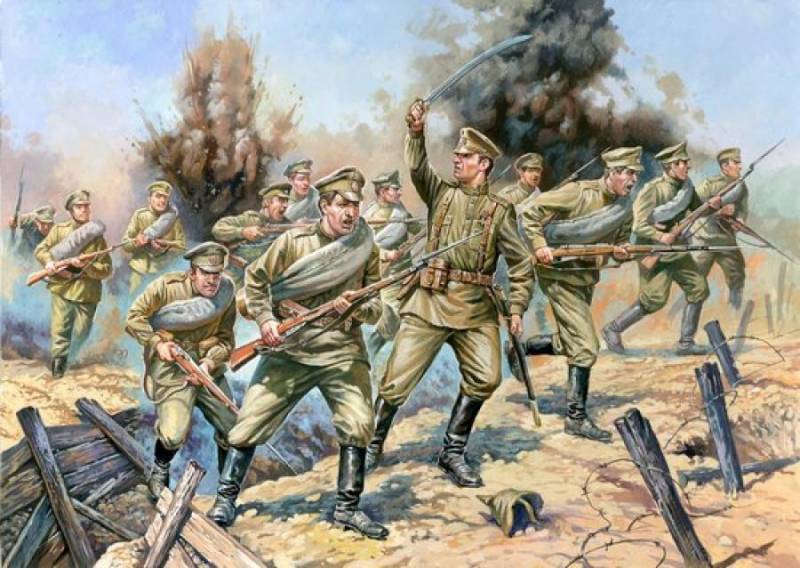
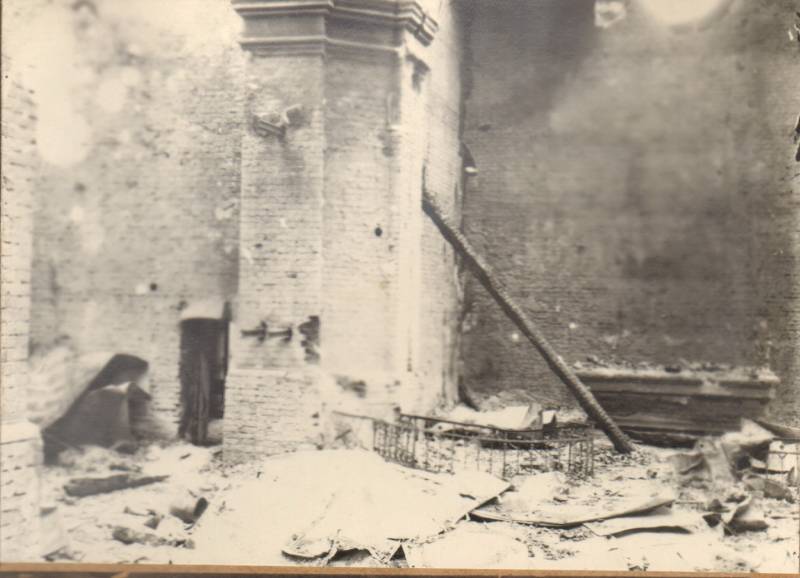
Information